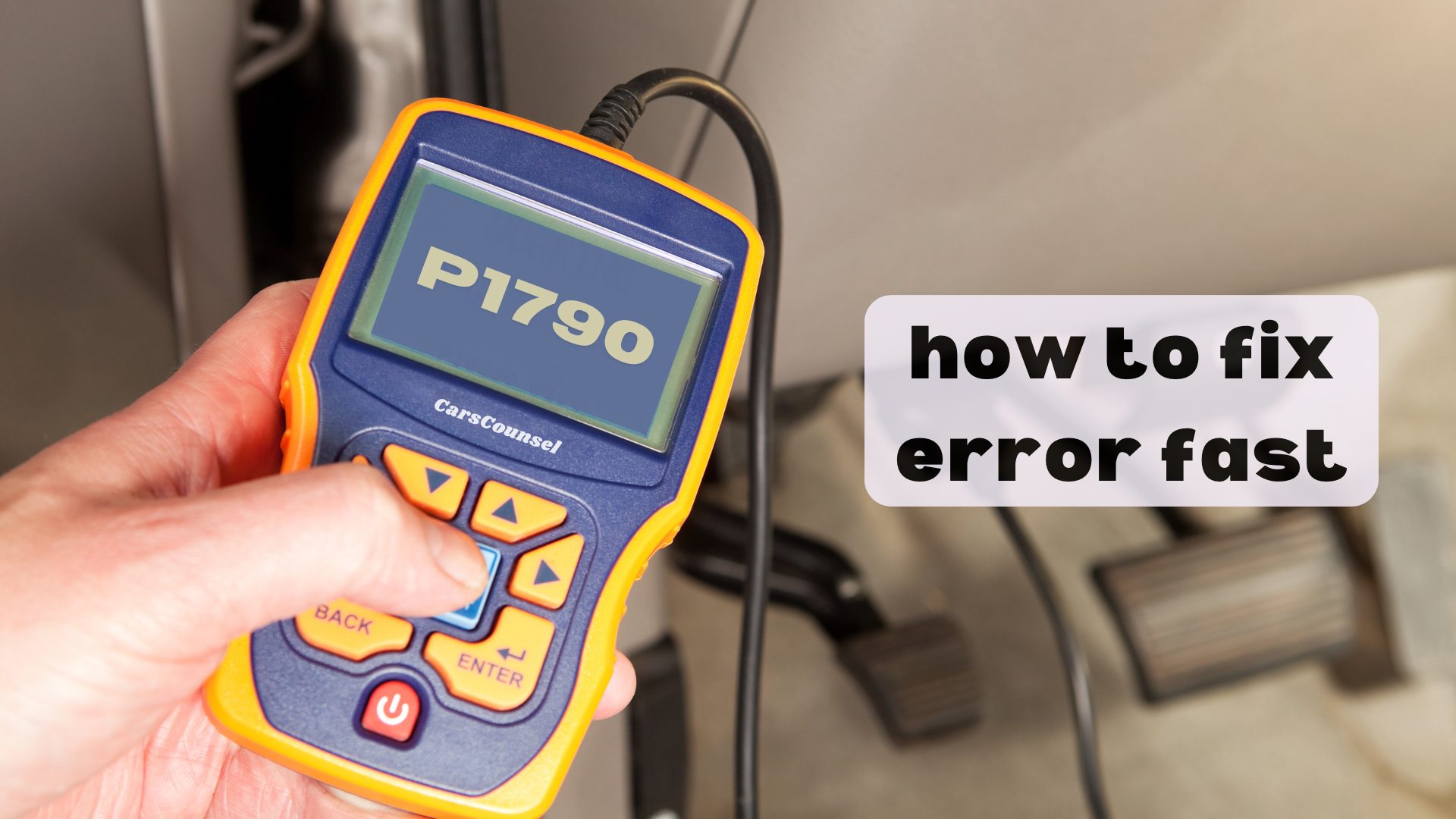You might think fixing the P1790 code is too tough for you, but with a few steps, you can handle it easily.
First, understand what this trouble code means: there’s a problem with your transmission control module‘s torque converter clutch system. If you’ve noticed erratic shifting and the check engine light is on, this is likely the issue.
To fix it quickly, you’ll need an OBD-II scanner, some basic tools, and a bit of patience.
Not sure where to start? Let’s go over the essential steps to diagnose and fix this error.

Quick Navigation
Key Takeaways
- Use a car diagnostic tool (OBD-II scanner) to find out what’s causing the P1790 error.
- Make sure the transmission fluid is at the right level for smooth operation.
- Look for and fix any damaged or rusty wires and connectors.
- Check and replace any faulty torque converter clutch solenoids.
Understanding the P1790 Code
The P1790 code means there’s a problem with the transmission control module‘s torque converter clutch system, which can cause unusual shifting and turn on the check engine light.
To understand this code, you need to be good at vehicle diagnostics. This code often means there’s a communication issue between the transmission control module (TCM) and the engine control module (ECM), which messes up the torque converter clutch system and hurts overall performance.
To diagnose it correctly, you’ll need an OBD-II scanner to get the P1790 code and any other related codes.
Regularly checking your transmission fluid levels and inspecting the wiring and connectors can help spot and fix problems early.
Common Symptoms
When dealing with a P1790 code, you’ll notice symptoms like erratic shifting, rough gear changes, and trouble shifting, often with the check engine light on.
These problems happen because of issues with the torque converter and clutch system. The torque converter mightn’t engage or disengage properly, causing inconsistent power transfer to the transmission.
The clutch system can also be affected, leading to sudden or harsh gear changes. You might also feel a delay or hesitation when accelerating.
It’s important to pay attention to these symptoms because they can signal underlying problems that, if not fixed, could cause serious transmission damage.
Getting a prompt diagnosis and repair is essential to keep your vehicle running well and safely.
Causes of the P1790 Code
Causes of the P1790 Code
Several things can cause the P1790 code, mainly related to problems with the transmission control module’s torque converter clutch system. A common issue is a faulty torque converter clutch solenoid, which manages the flow of transmission fluid. Damaged wiring or connectors can create short or open circuits, messing up signal transmission. Additionally, problems with the torque converter, low transmission fluid levels, or a failing transmission control module (TCM) can also trigger this error code.
| Cause | Description |
|---|---|
| Faulty Clutch Solenoid | Messes up fluid control, causing the error code |
| Damaged Wiring/Connectors | Disrupts signals, leading to malfunctions |
| Defective Torque Converter | Worn or broken parts cause system errors |
Fixing these issues quickly ensures your vehicle runs smoothly.
Affected Car Models
The P1790 code often shows up in several car models because of problems with their transmission control modules (TCMs). These models include the Nissan Altima, Ford Focus, Jeep Grand Cherokee, Toyota Camry, and Chevrolet Malibu.
For the Nissan Altima, this code usually points to issues with the TCM. Ford Focus owners also see this code because of transmission problems.
Jeep Grand Cherokee drivers report TCM faults causing the P1790 code, and some Toyota Camry models have similar transmission control issues. Chevrolet Malibu drivers encounter this code due to transmission problems as well.
Knowing which car models are affected can help you find the problem faster and take quick action. Regularly checking and maintaining the TCM and related parts is essential to prevent and fix the P1790 code effectively.
Using an OBD-II Scanner
To figure out the P1790 code, start by using an OBD-II scanner.
First, make sure the scanner works with your car. You can usually find the OBD-II port under the dashboard.
Plug in the scanner, turn it on, and choose the mode to read the error codes. Look for the P1790 code and any other related codes.
Some scanners can also show live data and run system tests, which can help you see how your transmission is performing in real-time.
Make sure the scanner is right for your car to avoid mistakes.
Writing down the data can help you spot patterns and specific issues.
Checking Transmission Fluid
Checking your transmission fluid regularly is important for keeping your vehicle running smoothly and avoiding problems like the P1790 code. Start by looking at the fluid to see if it’s in good shape; it should be clear and have a reddish color, not dark or smell burnt. Check your car’s manual to know how often you should change the fluid. If the fluid is low or looks bad, it can mess up the torque converter clutch system and cause the P1790 code.
| Fluid Condition | What to Do | When to Check |
|---|---|---|
| Clear and red | No action needed | Follow the schedule |
| Dark or burnt | Change the fluid | Right away |
| Low level | Refill to proper level | As needed |
Keeping your transmission fluid in good condition helps your car perform its best and prevents future problems.
Inspecting Wiring and Connectors
Inspecting the wiring and connectors means checking them closely for any damage, rust, or loose connections that might mess up the transmission system’s signals.
Start by looking at the harness to see if any wires are worn out, cracked, or exposed.
Check all the connectors to make sure there’s no rust, which can mess with the electrical flow.
Use a multimeter to test if the wires are working properly and ensure there are no breaks or short circuits.
Pay extra attention to areas where the wires might be rubbing against metal parts, as this can make them wear out faster.
Tighten or reconnect any loose connections, and replace any damaged parts right away to keep the transmission working well and stop the P1790 code from coming back.
Testing Torque Converter Clutch Solenoid
After making sure all the wires and connectors are in good shape, you need to use a multimeter to check the torque converter clutch solenoid’s resistance and continuity. This helps you figure out if the solenoid needs to be replaced.
Here’s how you do it:
- Unplug the Solenoid: Disconnect the solenoid from its electrical connector.
- Set the Multimeter: Turn your multimeter to the ohms setting.
- Check Resistance: Put the probes on the solenoid terminals and see if the resistance matches the manufacturer’s specs.
- Check Continuity: Make sure there’s no broken circuit by checking for continuity.
If the readings aren’t within the specified range, you need to replace the solenoid. Doing this correctly helps you avoid mistakes and makes sure the P1790 code is fixed.
Evaluating TCM Functionality
To check if the TCM (Transmission Control Module) is working right, connect a scanner to the car’s OBD-II port to get any error codes and see live data from the module.
Look for any odd behavior, like slow responses or wrong data. If you find problems, you might need to replace the TCM.
However, sometimes just updating the software can fix communication issues between the TCM and other parts of the car. Always see if there are software updates for the TCM before deciding to replace it.
Reprogramming the TCM can often make it work normally again without needing to buy new parts. Make sure the TCM’s firmware is current to avoid ongoing problems.
Repair and Preventative Measures
Once you’ve checked that the TCM is working properly or updated its software, you can move on to fixing the P1790 code. Here are some steps to help you solve the problem quickly and efficiently:
- Replace Broken Parts: If the torque converter clutch solenoid isn’t working, replace it.
- Fix Wiring Issues: Repair or replace any damaged or corroded wires to ensure proper signal transmission.
- Maintain Transmission Fluid: Flush and refill the transmission fluid, making sure it meets the manufacturer’s standards.
- Reprogram or Replace the TCM: If needed, reprogram or replace the TCM to make sure it works correctly.
More OBD-II Codes
Frequently Asked Questions
Can the P1790 Code Cause Long-Term Engine Damage if Left Unresolved?
If you don’t fix the P1790 code, it can lead to serious problems like heavy wear on the transmission and possible engine strain. Taking care of it quickly will help avoid major damage and keep your car running well and safely.
What Is the Average Cost of Repairing a P1790 Code Issue?
To fix a P1790 code, you can usually expect to pay between $200 and $600 for parts and labor. Additionally, diagnostic fees might cost an extra $50 to $100, depending on your mechanic’s rates and where you live.
Are There Temporary Fixes for the P1790 Code to Use Until Professional Repair?
You can try temporary fixes like resetting the TCM (Transmission Control Module) or making sure the fluid levels are correct. Use diagnostic tools to keep an eye on any changes. These are just short-term solutions; you’ll need a professional repair to avoid more damage.
How Often Should I Have My TCM Software Updated?
You should update your TCM software at least once a year or follow the schedule in your car’s manual. Regular updates keep your transmission running smoothly and prevent problems from old software.
Can Driving Habits Contribute to the Development of the P1790 Code?
Absolutely, the way you drive can definitely impact your transmission. Driving aggressively, stopping and starting a lot, and towing heavy loads can all speed up wear and tear, which might lead to the P1790 code showing up.
Conclusion
By understanding the P1790 code, you can quickly fix erratic shifting and get your vehicle running smoothly again.
Use an OBD-II scanner to find the issue, check the wiring, and make sure the transmission fluid is at the right level.
If needed, replace faulty parts like the torque converter clutch solenoid and update or reprogram the TCM.
Think of regular maintenance as protection for your transmission, helping to prevent future problems.
Stay proactive, and your car will thank you.

